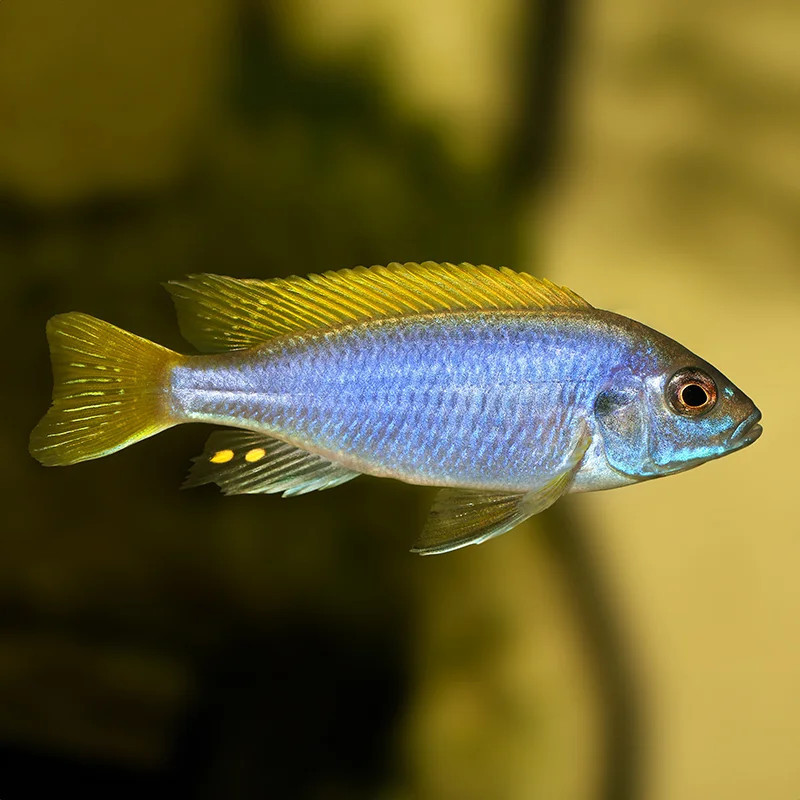Stocks Available
DEMASONI CICHLID
SKU:121585
PSEUDOTROPHEUS DEMASONI
N/A

Stock Available
Introduction: Species: Pseudotropheus acei Common Names: Acei Cichlid, Yellow Tail Acei Natural Habitat: Native to the rocky shorelines of Lake Malawi in East Africa. The Acei Cichlid is typically found in areas with rocky substrates and open spaces, where it can graze on algae and search for food. Physical Characteristics: Appearance: The Acei Cichlid is characterized by its elongated body, vibrant blue coloration, and distinctive yellow or golden tail. Males generally exhibit brighter colors and larger dorsal fins compared to females. Size: Grows to about 5-7 inches (12-18 cm) in length. Lifespan: Typically lives for 5-8 years with proper care. Habitat Requirements: Tank Size: A minimum of 50 gallons is recommended for a small group; larger tanks are preferred for better swimming space and territory establishment. Water Conditions: Temperature: 76-82°F (24-28°C). pH: 7.5-8.5 (alkaline). Hardness: Hard water (10-20 dGH). Aquascaping: Provide a well-structured aquarium with plenty of hiding spots using rocks, caves, and open swimming areas to mimic their natural habitat. Diet: Primary Diet: Herbivorous; in the wild, they primarily graze on algae and plant matter. Supplemental Feeding: In captivity, offer high-quality cichlid pellets or flakes, supplemented with spirulina and blanched vegetables like zucchini or spinach. Feeding Frequency: Feed small portions 1-2 times a day for optimal health, ensuring any uneaten food is promptly removed to maintain water quality. Compatibility: Temperament: Generally peaceful but can be territorial, especially during breeding. Suitable Tank Mates: Compatible with other African cichlids and peaceful community fish of similar size; ideal tank mates include other Mbuna species. Incompatibilities: Avoid keeping with larger, aggressive species or small fish that may be stressed or harmed by the Acei Cichlid. Care Level: Difficulty: Moderate; requires stable water parameters and regular maintenance to thrive. Health Monitoring: Monitor for signs of disease, especially stress-related issues and common parasites. Regular water changes and good filtration are essential for their overall health. Breeding: Breeding in Captivity: Breeding is possible with suitable conditions; they are mouthbrooders. Spawning: The female will lay eggs in a hidden area, and the male will fertilize them. The female then carries the eggs in her mouth until they hatch. Economic Considerations: Market Demand: The Acei Cichlid is popular among freshwater aquarium enthusiasts due to its vibrant colors and dynamic behavior. Wholesale/Retail Pricing: Prices can vary but are generally affordable, making them accessible for many aquarists. Sustainability and Conservation: Wild Population: While not currently endangered, the Acei Cichlid faces threats from habitat degradation and pollution. Aquaculture Efforts: Often bred in captivity to meet market demand and reduce reliance on wild populations. Regulations: Compliance with local and international regulations regarding the trade of freshwater fish is essential for conservation. Conclusion: The Acei Cichlid is a vibrant and attractive addition to freshwater aquariums, valued for its stunning coloration and engaging behavior. Their care requirements and breeding habits make them suitable for both novice and experienced aquarists. With proper attention to their habitat and dietary needs, Acei Cichlids can thrive, enhancing the beauty and liveliness of any aquarium setting.
Data sheet
7 other products in the same category: